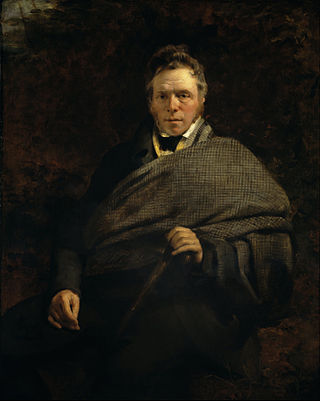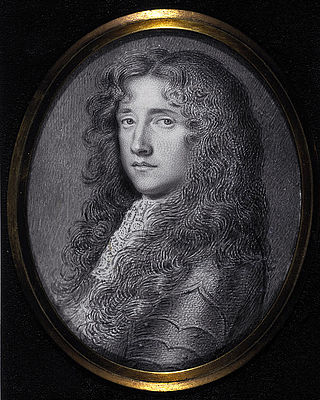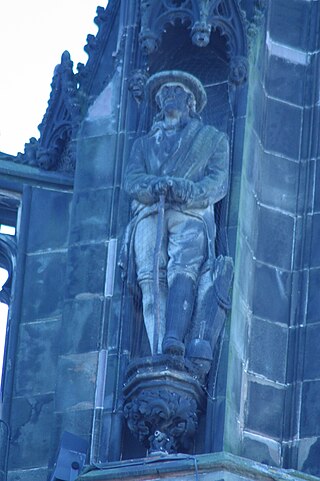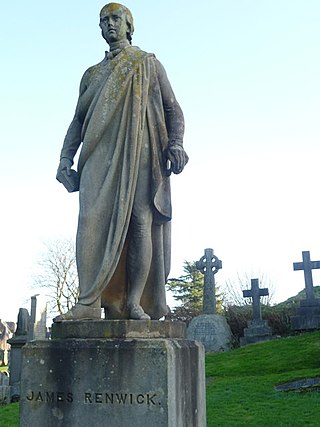Related Research Articles

James Hogg was a Scottish poet, novelist and essayist who wrote in both Scots and English. As a young man he worked as a shepherd and farmhand, and was largely self-educated through reading. He was a friend of many of the great writers of his day, including Sir Walter Scott, of whom he later wrote an unauthorised biography. He became widely known as the "Ettrick Shepherd", a nickname under which some of his works were published, and the character name he was given in the widely read series Noctes Ambrosianae, published in Blackwood's Magazine. He is best known today for his novel The Private Memoirs and Confessions of a Justified Sinner. His other works include the long poem The Queen's Wake (1813), his collection of songs Jacobite Relics (1819), and his two novels The Three Perils of Man (1822), and The Three Perils of Woman (1823).

John Graham, 7th of Claverhouse, 1st Viscount Dundee was a Scottish soldier and nobleman, a Tory and an Episcopalian. He was responsible for policing southwest Scotland during and after the religious unrest and rebellion of the late 17th century, and went on to lead the Jacobite rising of 1689.

Bonnie Dundee is the title of a poem and a song written by Walter Scott in 1825 in honour of John Graham, 7th Laird of Claverhouse, who was created 1st Viscount Dundee in November 1688, then in 1689 led a Jacobite rising in which he died, becoming a Jacobite hero.

Patrick Fraser Tytler FRSE FSA(Scot) was a Scottish advocate and historian. He was described as the "Episcopalian historian of a Presbyterian country".

The Private Memoirs and Confessions of a Justified Sinner: Written by Himself: With a detail of curious traditionary facts and other evidence by the editor is a novel by the Scottish author James Hogg, published anonymously in 1824.

Old Mortality is one of the Waverley novels by Walter Scott. Set in south west Scotland, it forms, along with The Black Dwarf, the 1st series of his Tales of My Landlord (1816). The novel deals with the period of the Covenanters, featuring their victory at Loudoun Hill and their defeat at Bothwell Bridge, both in June 1679; a final section is set in 1689 at the time of the royalist defeat at Killiekrankie.
A Legend of Montrose is an historical novel by Sir Walter Scott, set in Scotland in the 1640s during the Wars of the Three Kingdoms. It forms, along with The Bride of Lammermoor, the 3rd series of Scott's Tales of My Landlord. The two novels were published together in 1819.

One of the Waverley Novels by Walter Scott, The Black Dwarf was part of his Tales of My Landlord, 1st series (1816). It is set in 1708, in the Scottish Borders, against the background of the first uprising to be attempted by the Jacobites after the Act of Union.

The Killing Time was a period of conflict in Scottish history between the Presbyterian Covenanter movement, based largely in the southwest of the country, and the government forces of Kings Charles II and James VII. The period, roughly from 1679 to the Glorious Revolution of 1688, was subsequently called The Killing Time by Robert Wodrow in his The History of the Sufferings of the Church of Scotland from the Restoration to the Revolution, published in 1721–22. It is an important episode in the martyrology of the Church of Scotland.

The Battle of Drumclog was fought on 1 June 1679, between a group of Covenanters and the forces of John Graham of Claverhouse, at Drumclog, in South Lanarkshire, Scotland.
Dainty Davie is a folk song, possibly of Scottish origin, which is still part of the repertoire of Scottish and Irish traditional music. It has a long history and two different tunes, both of which have been used for several texts, the best known of which are by Robert Burns.
Events from the year 1832 in Scotland.

The blue bonnet was a type of soft woollen hat that for several hundred years was the customary working wear of Scottish labourers and farmers. Although a particularly broad and flat form was associated with the Scottish Lowlands, where it was sometimes called the "scone cap", the bonnet was also worn in parts of Northern England and became widely adopted in the Highlands.
The Three Perils of Man; or, War, Women, and Witchcraft. A Border Romance (1822) is a novel by James Hogg set in the Scottish Borders during the reign of Robert II, King of Scots (1371–90).
The Mountain Bard (1807), containing 21 poems, was James Hogg's first substantial poetical publication.
Winter Evening Tales is a collection by James Hogg of four novellas, a number of short stories and sketches, and three poems, published in two volumes in 1820. Eleven of the items are reprinted, with varying degrees of revision, from Hogg's periodical The Spy (1810‒11).
A Queer Book (1832) is a collections of 26 poems, mostly short narratives, by James Hogg, all but two of which had been previously published, more than half of them in Blackwood's Edinburgh Magazine.
Altrive Tales (1832) by James Hogg is the only volume to have been published of a projected twelve-volume set with that title bringing together his collected prose fiction. It consists of an updated autobiographical memoir, a new novella, and two reprinted short stories.
The Shepherd's Calendar (1829) is a collection by James Hogg of 21 articles, most of which had appeared in Blackwood's Edinburgh Magazine since 1819. They are set in, or deal with aspects of, the Scottish Borders, in particular Hogg's native Ettrick Forest.

John King was an outlawed minister of the Covenant, chaplain at one time to Lord Cardross, but seized by Claverhouse among the insurgents after the affair at Drumclog. King was taken to Edinburgh along with another preacher named John Kid. They were each subjected to torture, condemned to death, and executed. Following his death King's head and limbs were displayed at the Netherbow Port on Edinburgh's Royal Mile beside James Guthrie's skull.
References
- ↑ James Hogg, The Brownie of Bodsbeck, ed. Douglas S. Mack (Edinburgh and London, 1976), xv‒xvi.
- ↑ The Collected Letters of James Hogg: Volume 1 1800‒1819, ed. Gillian Hughes (Edinburgh, 2004), 289: Hogg to Blackwood, 4 January 1817. Compare Hogg's further letter to Blackwood of 13 January 1818 on the same subject and specifically mentioning The Brownie: ibid., 325‒26.
- ↑ Ibid., 325 (13 January 1818) and 329 (31 January 1818).
- ↑ James Hogg, 'Memoir of the Author's Life' in Altrive Tales, ed. Gillian Hughes (Edinburgh, 2003), 45‒46. Compare Familiar Anecdotes of Sir Walter Scott in James Hogg, Anedcotes of Scott, ed. Jill Rubenstein (Edinburgh, 1999), 51.
- ↑ The Collected Letters of James Hogg': Volume 3 1832 to 1835, ed. Gillian Hughes (Edinburgh, 2008), 193: Hogg to Blackie & Son, 11 November 1833); Mack, op. cit., xxiii‒xxiv.